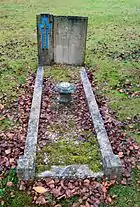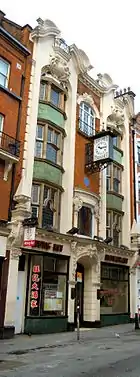Willy Clarkson
William Berry "Willy" Clarkson (1861 - 12 October 1934)[1] was a British theatrical costume designer and wigmaker.
Willy Clarkson | |
|---|---|
 Willy Clarkson in 1906 | |
| Born | 1861 |
| Died | 12 October 1934 (aged 72–73) |
| Resting place | Brookwood Cemetery |
| Nationality | British |
| Occupation | Theatrical costume designer/wig maker |
Career
Clarkson's father had been making wigs since 1833 and Willy Clarkson took over his father's business in 1878.[2] In an 1898 court case Clarkson was fined for the offence of employing women in a factory on a Sunday.[2]
The business became prominent and very successful. A 1900 article in the theatrical newspaper The Era stated that "Not to know Willy Clarkson and his doings is to be out of the theatrical world, for Willy Clarkson, with the bright and easy (though sometimes anxious) manner is ever hovering 'before and behind.' Scarcely any big production in London is undertaken without the aid of the owner of the Wellington-street wiggeries."[2]
Clarkson's company supplied costumes and wigs used in the amateur dramatic productions of Queen Victoria's family and circle.[3] In the 1920's, he was the owner of the Duchess Theatre in Catherin Street.[4] In 1936, Adrian Stephen recalled that Clarkson had helped disguise the members of Horace de Vere Cole's Dreadnought hoax in 1910. Among the hoaxers was a young Virginia Woolf, disguised as a member of an Abyssinian royal delegation.[5]
Clarkson was claimed to have created disguises for murderers Hawley Harvey Crippen and Jack the Ripper.[6] Clarkson would also make disguises for detectives from Scotland Yard.[2]
During his life, there were widespread rumours of Clarkson's homosexuality, at that time a crime under the Criminal Law Amendment Act 1885. A public lavatory in Soho's Dansey Place was known locally as Clarkson's Cottage.[4]
Death

Clarkson died on 12 October 1934. The circumstances of his death were considered sufficiently suspicions that an autopsy on his body was performed by the prominent pathologist, Sir Bernard Spilsbury, although he found no conclusive evidence of foul play.[4] Clarkson was buried in a modest grave in the Actors' Acre in Brookwood Cemetery in Surrey, England.
Clarkson's will, dated 1929, left the bulk of his estate to William Cooper Hobbs, previously a solicitor's clerk, but a convicted blackmailer. The two had had a long association; in 1922 Clerkson had helped Hobbs attempt to flee the country when he was facing serious criminal charges. But the attempt failed and Hobbs was arrested at Gravesend while attempting to board a ferry to Rotterdam[7] Hobbes was convicted and sentenced to two years in prison for attempting the blackmaail Hari Singh for £150,000
However the will was contested by Max Brezinski and his daughter who possessed a 1931 will in which Clarkson left his estate to them. Brezinski was a stage magician who performed under the name of Fred Brezin.[8] The Probate court decided in their favour in July 1935.[4][8] In March 1938, Hobbs and a former solicitor, Edmond O'Connor went on trial, accused of together forging Clarkson's will. Both were convicted; Hobbes was later sentenced to five years in prison and O'Connor to seven.[9]
In 1937, insurance companies filed suits against Clarkson's estate for the recovery of money paid to him when alive. Investigation showed he had made nine claims for fire damage over the course of 40 years. A 1931 fire insurance claim was proved fraudulent and a 1933 claim was refused. This led to the trial of another man, Leopald Harris. Harris was an insurance assessor and a former associate of Clarkson, who had organised a gang that carried out arson for the purpose of insurance fraud.[4]
Legacy
A London County Council blue plaque unveiled in 1966 commemorates Clarkson at 41-43 Wardour Street in Soho.[10] The foundation stone of Clarkson's Wardour Street premises (then Wellington Street) was laid by the actress Sarah Bernhardt and the coping stone by actor Henry Irving.[11] Clarkson's occupied the building from 1905 to 1940.[12] The building retains a clock above the entrance, advertising it is the business premises of a Costumer and Perruquier - one who makes and sells perukes (wigs or hair pieces). The building is currently occupied by the well-known Wong Kei Chinese restaurant.
Clarkson's ability at creating disguises is referenced in novels by Sax Rohmer (The Golden Scorpion, 1919) and Graham Seton Hutchison (Colonel Grant's To-morrow, 1931).[13][14]
Jack the Ripper Suspect
Clarkson has been named as a potential suspect in the 1888 White Chapel Murders attributed to "Jack the Ripper."[15] This theory was first introduced and explored in the award-winning 2019 short film "The Wigmaker of Wellington Street."[16]
Gallery
 The former premises of Willy Clarkson on Wardour Street
The former premises of Willy Clarkson on Wardour Street The blue plaque commemorating Clarkson in Wardour Street
The blue plaque commemorating Clarkson in Wardour Street Plaque commemorating the foundation stone laid by Sarah Bernhardt in 1904
Plaque commemorating the foundation stone laid by Sarah Bernhardt in 1904 Plaque commemorating the coping stone laid by Henry Irving in 1905
Plaque commemorating the coping stone laid by Henry Irving in 1905
References
- Citations
- James Morton (1 March 2012). Gangland Soho. Little, Brown Book Group. pp. 80–. ISBN 978-1-4055-1559-7. Retrieved 19 August 2012.
- "Clarkson's Wigs, Wellington Street, London". Arthur Lloyd. Retrieved 18 August 2012.
- R. Schoch (28 January 2004). Queen Victoria and the Theatre of Her Age. Palgrave Macmillan UK. pp. 24–36. ISBN 978-0-230-28891-1.
- Mike Hutton (15 March 2012). The Story of Soho: The Windmill Years 1932-1964. Amberley Publishing Limited. p. 37. ISBN 978-1-4456-1231-7.
- Stanford Patrick Rosenbaum (1995). The Bloomsbury Group: A Collection of Memoirs and Commentary. University of Toronto Press. pp. 7–. ISBN 978-0-8020-7640-3. Retrieved 19 August 2012.
- "Stephen Fry: the joy of plaques". The Telegraph. 9 June 2009. Retrieved 18 August 2012.
- Barbara Jeffery (15 August 2019). Chancers: Scandal, Blackmail, and the Enigma Code. Amberley Publishing. pp. 103–. ISBN 978-1-4456-8979-1.
- "High Court Of Justice". The Times (47124). London. 24 July 1935. p. 4.
- "O'Connor and Hobbes Sentenced". The Times (47958). London. 30 March 1938. p. 4.
- "CLARKSON, WILLY (1861-1934)". English Heritage. Retrieved 18 August 2012.
- Christopher Hibbert Ben Weinreb; John & Julia Keay (9 May 2011). The London Encyclopaedia (3rd Edition). Pan Macmillan. pp. 984–. ISBN 978-0-230-73878-2. Retrieved 19 August 2012.
- "Rupert Street Area". British HistoryOnline. Retrieved 18 August 2012.
- Sax Rohmer (March 2009). The Golden Scorpion. Wildside Press LLC. pp. 220–. ISBN 978-1-4344-5106-4. Retrieved 19 August 2012.
'In that bag,' he continued, 'is a suit of clothes such as habitues of 'The Pidgin House' rejoice to wear. I, who have studied disguise almost as deeply as the great Willy Clarkson, will transform you into a perfect ruffian.'
- Graham Seton Hutchison. Colonel Grant's To-morrow. Taylor & Francis. pp. 59–. Retrieved 19 August 2012.
- List of Jack the Ripper Suspects: Willy Clarkson
- Olson, Chris, "Review of The Wigmaker of Wellington Street," UK Film Review, 11 Sept. 2019
- Bibliography
- Greenwall, Harry J (1936). The strange life of Willy Clarkson; an experiment in biography,. London: J. Long. OCLC 2162440.